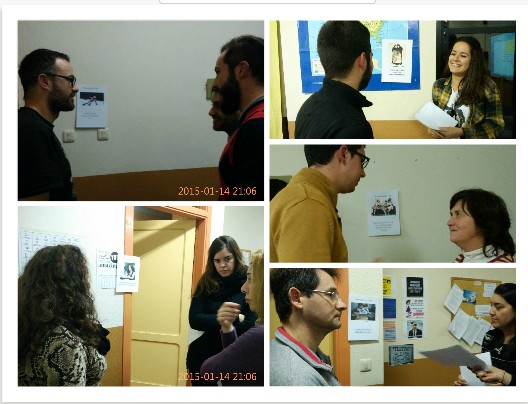Click here to see the Infographic in Presentation Mode
Click to follow Blog de Cristina


What do you normally do when you are talking to a person in English and you don’t know the word? I guess you don’t tell the person ” OK, right, hold on! I am going to look it up on my mobile phone”. You might be tempted to do it, but know that the person you are talking to might lose interest in what you are saying.
So, the thing to do would be Paraphrasing.
How do we paraphrase?? There are some expressions you can use
It’s A KIND OF house
It’s THE OPPOSITE OF lazy
It’s LIKE cleaning but… trying to explain what you want to say but using other words you know. That’s calle
It’s SIMILAR TO book but..
FOR EXAMPLE, you do this when
It’s A SYNONYM OF..
It’s A PERSON/SOMEBODY WHO…
It’s a THING/SOMETHING WHICH…
It’s SOMEWHERE/A PLACE WHERE
It can also help to say “ It’s a noun, or an adjective…. “ If it’s an expression, you can also say “ It’s an expression and there are three words in it”

Right, now we are ready to play the game. It’s called WHAT’S THE WORD?
How we play the game:
My beloved father was a chauvinist doctor and my mother was an undercover feminist. I am sure you’ve heard the saying “opposites attract”and that appeared to be the case with my parents. It was not an easy combination to live with. My father was the main breadwinner and my mother was the housewife. These were their roles in the house and to be honest, I don’t think my mother had an issue with that arrangement. The problem was he expected us (three sisters) to fully cooperate doing housework while my only brother did nothing but smile when we complained it was unfair. My father, on the other hand, and contradictorily, expected us to get the best marks at school ’cause we were expected to go to university and get a degree so as not be the housewife my mother was. Who understands men? 😉
Today I want to share with you a lesson I did with my Intermediate students about Gender Stereotypes. This is a lesson where common general stereotypes about men and women are challenged.
Level: B1/B2
Aim: Get students to discuss general stereotypes about men and women using different expressions to give opinion.
STEPS
1. Give handouts containing expressions used to give opinion. Here. Encourage students to use a variety of expressions when they give opinion.
2. Ask Do you know any stereotypes about men and women? Instruct students to talk for about five minutes and then ask them to give feedback.
3. Play the video Differences between Men and Women to get students into the mood. It’s a funny little video. I hope nobody takes offence.
4.Using Blue-tack, stick the posters containing the statements they need to discuss on the walls of the classroom. Posters here

5. Ask students to, working in twos or threes, wander around the classroom and randomly choose the posters they want to discuss.

Sticking posters on the walls of the classroom enables students to get out of their seats and talk to different people. As always it is important to make sure they understand the importance of using English and only English.
Learn English and have fun!
This year is slightly different for me since I don’t have as much time as the previous years to update my blog. This year I have found myself with a job to go to , a rural house to run and with no domestic help. I wasn’t sure I ‘d be able to post, if I’d have time or if I’d feel up to it and heck, I am still wondering where I find the time to do everything. But the thing is that here I am, still pumped to post.Today I want to share with you a little tool you might find useful .
This little tool is a cueprompter. My students need to, in two weeks’ time, give a speech of two minutes maximum and I find this little tool can help them a lot monitor the time it takes them to give their speech as it has adjustable speed feautures.
How to use it
♥Copy/paste the text into the prompter text window
♥You can set screen size, font size and colour
♥Start the prompter and adjust the speed
♥ Use the Space Bar to stop/start the cueprompter
Tutorial here
Level: Intermediate
Step 1. Warm up
A: Students watch the video. Unless they beg for more, I would just play the first 15 seconds, enough for students to focus on the pronunciation of the word “money” which they tend to mispronounce, and on the chorus Money makes the World Go Round, which students will later need to discuss.
B: This second warm-up is a great one. I got it straight from George Chilton‘s blog Designer Lessons – I copy/paste from him–, which I highly recommend.
Ask your students how they would spend a day in their city/town/village without spending any money. What activities could they do? They’re not allowed to stay at home, they have to be out of the house for the whole day.
Put them in small groups and get them to come up with a plan of the day – from 10 am until 8 pm. Conditions – They are allowed to drink water from city water fountains and any food that they find. They should present their plans at the end of this activity.
Step 2. A Bit of Fun with Translation.
Previous to this exercise students have studied Vocabulary related to money, so now it’s their time to show what they have learned.
Students work in pairs or in threes. To make things easier for me, I’ll provide them with slips of paper so that when the time’s up they can raise it up and I can have a quick check. Sentences with mistakes will be automatically discarded and the correct translations will get one point. Time limit: 90 seconds.
Step 3. Speaking. Speed Dating Technique.
♥Photo and explanation of the technique here .
♥Money Questions here